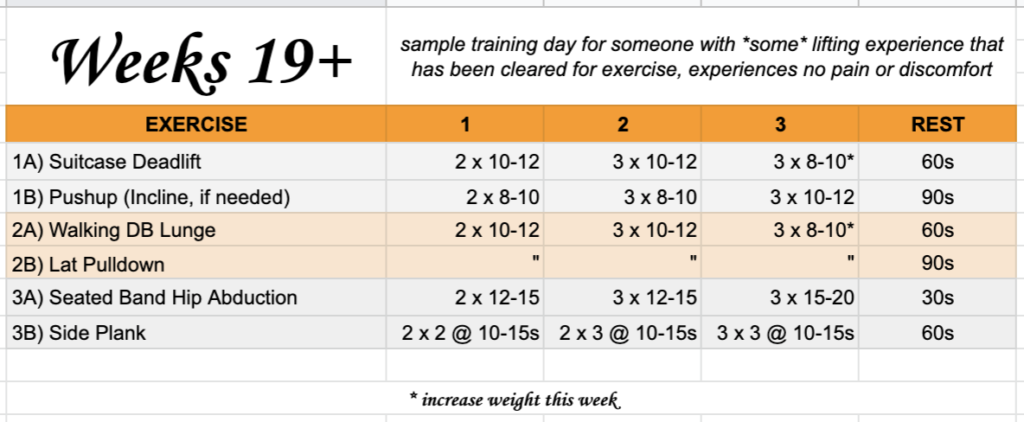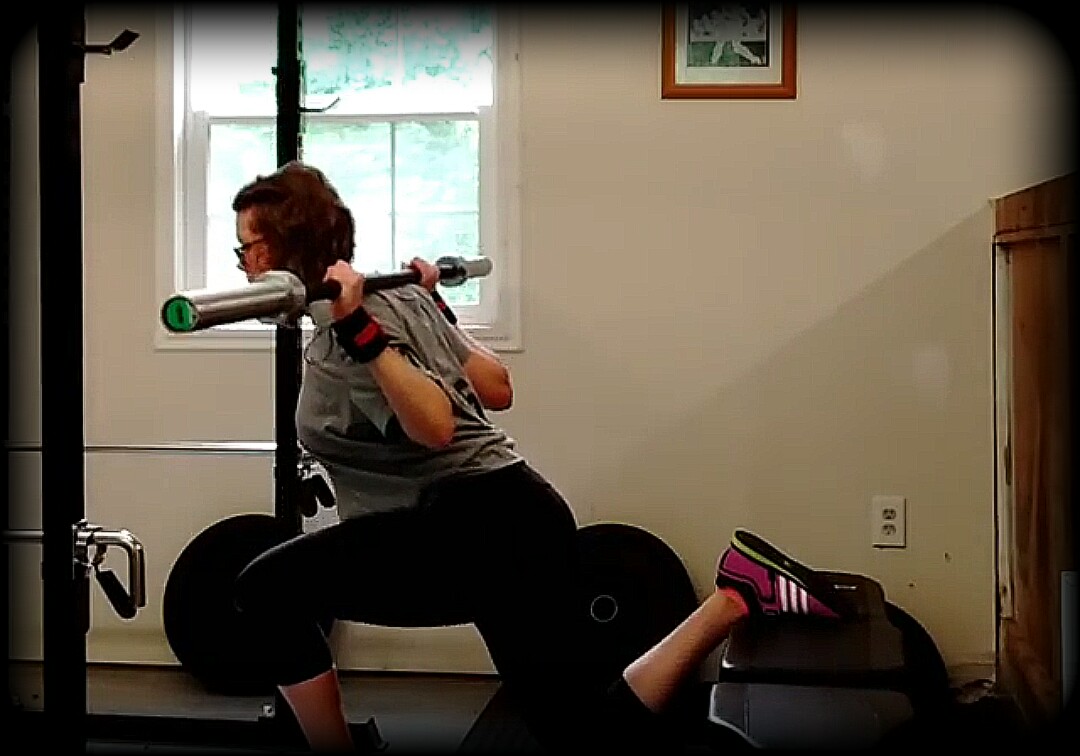
Access weeks 0-6 here and weeks 7-18 here.
Can you believe that your mini-me is nearly 5 months old? This far out from pregnancy and delivery, you’ve likely started to build a new routine with your new family, begun training (even if just a little), and maybe even strapped your skates back on. At this point, assuming you’ve been taking care to recover enough and return to exercise slowly and steadily, you’re REALLY REALLY ready to finally have the question answered:
HOW DO I ACTUALLY RETURN TO SKATING?
The most important thing for you to know in this stage of postpartum is that if you haven’t been taking time to recover, rehab, and slowly return to exercise, YOU CANNOT JUST JUMP IN. There’s that old saying that “time heals all wounds” and you’ve been postpartum for a time now. But time doesn’t heal all wounds well. That’s what rehab and rest are for.
This is around the time that most folks start to feel like they’re figuring out this whole parenting thing. And feel ready to get back into training fully and putting their skates back on. That’s great! Mental and emotional readiness are really important when it comes to lacing up your skates again. However, there are some things to keep in mind as you reach this point:
- You cannot jump back into the type of training and skating you did prior to pregnancy. If you haven’t been easing yourself into gentle movement and taking care of your core function, go back up and read the first two articles.
- There is a gap between where your brain thinks you are physically and what your body can actually accomplish. That doesn’t mean you’ve lost skating skill or strategy knowledge or track awareness. It just means that your brain and body need to remember how to communicate efficiently again and that takes a little time.
- You’ll have good days and bad days. On skates and in the gym. Give yourself grace, you’re juggling a lot.
- You are still early postpartum. Remember that in all things.
This article is going to assume that you are currently in a place where you are ready, able, and excited to return to training and skating postpartum. If that’s not the case, start at the start regardless of how far into postpartum you are. This information is heavily pulled from the certification programs I went through to work with pregnant and postpartum folks from both Girls Gone Strong and Brianna Battles.
With all the disclaimers out of the way, let’s talk about your timeline to returning.
Oh, wait. One last disclaimer. Every pregnancy, delivery, and the postpartum period is different for every birth. It’s important to keep in mind that you need to be flexible when it comes to following this timeline. There may be points at which you can move more quickly but there are likely also points that you’ll need to slow down.
Approach your postpartum training with INTENTION now so that you can approach it with INTENSITY in a few months.
Weeks 19-42 Postpartum
We’re going to call this the “bulletproof your body” phase. Now that you’ve eased back into simple training and gentle movement, rebuilt your core, and found a routine, we can take it up a notch. You may have felt well enough and been appropriately cleared by your Pelvic Floor Physical Therapist to move into higher impact exercise and higher intensity cardio earlier than this (in which case, go you!) but if you’re rehabbing on your own, this the time we want to start looking at increasing the intensity and volume of what you’re doing in the gym. In other words, the big focus here is starting lift heavier weights and really dialing in on things that will transfer to the track.
If you haven’t returned to practices yet, this is also a really important time to decide if you’re ready to return to skates. You may find that training for aerobic and strength improvements is difficult due to time constraints or fatigue and jumping back into skating isn’t in the cards yet. You may find that, once you start finding ways to train again, your body (and brain) are raring to go back.
RESPECT THIS PROCESS. Whatever it looks like for you. Roller derby will always be there when you’re ready for it. There’s no need to rush. Okay? Okay.
Here’s what you can do to maintaining and improving your core function, increasing training intensity, and starting to skate like you used to:
1) Continue maintenance pelvic floor exercises.
If you have a Pelvic Floor Physical Therapist, chances are good that you’ve been assigned a “maintenance” program for your pelvic floor. Just like with any PT recommendation, you want to keep these up to maintain function and stamina in your pelvic floor and core. Even if your core function wasn’t severely impacted by pregnancy, it’s still important to see a PFPT and work to maintain their current function.
Your core is where your power comes from so you definitely need it to work well.
At this point, your core should be functioning automatically. It shouldn’t be something you have to think about or focus on for most exercises in the gym. And we want that to carry over on to skates.
Again, this assumes that you did the work earlier on in your postpartum recovery to teach those muscles how to work together again. If you didn’t, pump the breaks and go back to the basics.
I do still use the connection breath in every one of my warm-ups (and my kiddo is 5 years old!) because it gives me a chance before I lift or skate to intentionally check-in with my core and pelvic floor.
2) Review your breathing pattern.
Basically, as you increase the intensity of your lifts or your gameplay, you want to take time to intentionally review how your breathing. If you’ve built up good breathing patterns in more basic exercises and gentle movements, it’s critical to make sure that those effective patterns are carried over to more difficult work.
The first few times you try a new and intense drill or lift, your natural tendency might be to hold your breath. Remember, we’re still in a phase of postpartum where we have to protect the core. Make sure that your breathing pattern gets carried into exercise as we make sure that we are exhaling THROUGH the most difficult part of an exercise and inhaling through the rest. (For example, in a squat you would inhale on the way down and exhale on the way up to create a bracing effect without producing too much intraabdominal pressure.)
Take new or more intense roller derby drills at 20% the first few times to check and see how you naturally hold your core and body tension. (Hey, coaches! If you’re reading this, allow your postpartum skaters to dictate what intensity they come at drills with until they can be sure they’re doing them safely and effectively.) Once you’ve figured out how to breathe through the drill, you can start increasing the intensity.
Final reminder here: If your breathing patterns start to get wonky again, that’s a good sign to dial down the intensity for a bit — in the gym or on skates — to teach your body that new pattern.
3) Increase aerobic exercise.
This subsection is alternately going to be titled “getting back on your fucking skates.” Because let’s all face it, that’s the primary aerobic exercise most of us want to be doing.
You may remember earlier in this article that I cautioned you about JUMPING RIGHT BACK IN and this goes double for returning to practices. If you’re ready to get your skates on, great, amazing, awesome. But you’re going to have to show some restraint and return slowly and steadily. (It really does win the race!)
Here’s an idea of what that might look like:
FIRST SESSION BACK ON SKATES — at practice or open session spend 30-60 minutes just tooling around, no drills, no fancy stuff, just skating and getting your wheels back under you
SESSIONS 2-5 — slowly increase the time that you’re on-skates (assuming your body responded well to session 1); still no drills or fancy stuffy, just skating around, feeling your wheels under you
SESSION 6-10 — slowly increasing your speed on skates (assuming your body responded well to sessions 2-5); start with short intervals of faster skating or sprints, then increase the intervals each subsequent session
SESSION 10 — start participating in non-contact drills with the team or new skaters, increase intensity in each subsequent session
SESSION 15 — start participating contract drills with the team or new skater, increase intensity in each subsequent session
These aren’t specific guidelines, just an idea of what a return to skates might look like. What’s most important in all of this is that you continually check-in with how your body feels as you get back to skating (or running or rowing or whatever your cardio is). Ask yourself these questions during and after your training sessions:
• Do you feel any heaviness in your perineum?
• Are you leaking urine?
• Did you experience any back or pelvic pain?
• Were you exhausted afterward?
If the answer to every question is NO, hooray! You can continue progressing back to full practice participation. If the answer is YES to any of these questions, it’s time to slow down, take a step back, and reconsult with your doctor and PFPT.
4) Progress your strength training.
Keep it up!
Strength training increases muscle and bone density, makes it easier to lug around your swiftly growing child, and helps to improve your mood. Give your brain that good ol’ endorphin bath. It probably needs it.
The key to progressing at this stage is to always make sure that your good posture and breathing techniques come with you as you do more difficult things. On skates and in the gym.
The questions from weeks 9-18 still apply:
• How is your breathing, core, and alignment in these exercises?
• Do you have full control of the movement?
• Can you comfortably add load or increase difficulty?
• Testing easier modification of an exercise before diving into a more difficult one (bodyweight squats THEN goblet squats THEN back squats)
• Improving aerobic fitness without increasing fatigue levels (start with lower impact, less often aerobic work then adjust from there)
• How does this training impact your sleep, appetite, mood, fatigue?
Remember, intention now and intensity later.
SAMPLE PROGRAM: Weeks 19+

Want More?
Join The DERBY, BABY! Facebook Group
It’s a FREE roller derby community created and sustained specifically for pregnant and post-partum roller derby athletes.
The goal is to provide a space for skaters to get evidence-based exercise and training advice to return to skating as quickly and safely as possible. Everyone’s journey is different but I promise that we can all get there.
ANSWER THE QUESTIONS!

